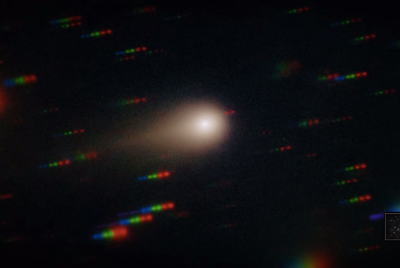3I/ATLAS: ESA Mars Probe Reveals Closest-Ever Images of 'Alien' Object
The ESA's Mars probe, TGO, captured the closest images ever of the interstellar comet 3I/ATLAS, improving its trajectory tenfold.

The arrival of an interstellar comet is a truly momentous astronomical event, but witnessing one up close, from the orbit of another planet? That is the stuff of science fiction. Yet, this remarkable scenario has become reality thanks to the tireless efforts of the European Space Agency (ESA).
Since its discovery on July 1, 2025, the interstellar comet 3I/ATLAS, which is travelling on an extreme hyperbolic trajectory with an eccentricity estimated to be between 6.1 and 6.2, has captivated the global scientific community.
This exceptional visitor, only the third confirmed interstellar object ever observed (following 1I/'Oumuamua and 2I/Borisov), presents a unique opportunity to sample the materials of a foreign star system.
Its peculiar behaviour and enormous speed have transformed it into a priority target. While it was initially observed exclusively by terrestrial telescopes and those orbiting our own planet, the ESA recently achieved a monumental first: capturing the object through a spacecraft orbiting Mars, giving researchers an unprecedented close-up perspective.

A Martian Viewpoint: ESA's Unprecedented Images of Comet 3I/ATLAS
Until September, the determination of the composition, precise location, and trajectory of 3I/ATLAS relied solely on ground-based telescopes. This reliance on a single, fixed viewpoint made tracking the high-velocity object extremely difficult. However, between October 1 and 7, 2025, a revolutionary opportunity arose.
The ESA's veteran spacecraft, the ExoMars Trace Gas Orbiter (TGO), launched in 2016 to study the Martian atmosphere, pivoted its instruments away from the Red Planet and towards the interstellar interloper. Located some 400 kilometres from the Martian surface, the TGO was able to locate the object and achieve a proximity never before reached by an ESA craft.
The orbiter's closest approach to 3I/ATLAS occurred on October 3, 2025, when it was positioned a remarkable 29 million kilometres away from the comet, a distance of just over 0.19 astronomical units.
To achieve this, the TGO employed its Colour and Stereo Surface Imaging System (CaSSIS), a highly specialised camera that was actually designed to point towards the surface of Mars and capture high-resolution images of geological features. Scientists were uncertain about the outcome, given that the comet was tens of millions of kilometres away and comparatively faint.
However, the result was a stunning technological victory: the positional precision of the comet's trajectory jumped by an impressive factor of ten compared to estimates based on ground-based telescopes.
The resulting images, revealed by ESA on October 7, show a white point slightly blurry moving down against a starry background. This point represents the centre of the comet, comprising its icy-rocky core and its surrounding gaseous cloud, or coma.
Although the distance was still too great for CaSSIS to distinguish the solid nucleus of the comet—imaging the kilometre-wide nucleus would have been as impossible as seeing a mobile phone on the Moon from Earth—it successfully captured the coma, which extends for thousands of kilometres.
Hubble Space Telescope observations from July 21, 2025, estimated the comet's nucleus diameter to be between 0.44 and 5.6 kilometres. The data obtained by ESA on comet 3I/ATLAS represents the first time that astrometric measurements from a spacecraft orbiting another planet have been officially submitted and accepted by the International Astronomical Union's Minor Planet Center, the worldwide information exchange database for observations of asteroids and comets.

Galactic Tracking: The Crucial Planetary Defence Exercise of 3I/ATLAS
The significance of these TGO observations extends far beyond simply cataloguing a rare space rock. The ability to use an orbiting spacecraft for this kind of triangulation drastically reduced the uncertainty regarding the object's location and trajectory, making future predictions much more accurate.
This tracking is crucial, as the comet reached an estimated speed of 246,000 kilometres per hour (153,000 miles per hour) at its closest point to the Sun (perihelion) on October 29, 2025.
Likewise, although 3I/ATLAS does not represent any threat to Earth, this operation served as a valuable exercise in planetary defence. The organisation demonstrated that it can adapt its existing fleet to detect and accurately track high-speed space objects long before they reach our planet, allowing, if ever necessary, time to issue warning signals and potentially mitigate a collision.
Following the triumphant observation with its Mars probe, ESA is continuing its interstellar chase. The agency is now following comet 3I/ATLAS with its Jupiter Icy Moons Explorer (JUICE), another of its spacecraft, and hopes to obtain optimal results in February 2026. This follow-up observation will leverage the spacecraft's instruments as the comet passes within 53.44 million kilometres of Jupiter in March 2026.
Final Approach: When Will Comet 3I/ATLAS Approach Earth?
3I/ATLAS, first reported on July 1, 2025, is the third interstellar object known (hence its name '3I'), after the discovery of 1I/'Oumuamua, in 2017, and 2I/Borisov, in 2019. However, this comet presents a series of peculiarities such as a very high speed and potentially enormous size, which transform it into a different species from its predecessors. Therefore, the astronomical community is eagerly awaiting the day it reaches its closest point with respect to the Earth.
According to data reported by NASA, the closest passage will occur when the comet is placed at a distance estimated to be 1.8 astronomical units (approximately 270 million kilometres) in relation to our planet.
This event will occur in December 2025 and, despite alarming theories on the internet, it will not represent a threat to Earth, because the object will pass safely far away. The European Space Agency went further, setting the exact date on which the comet will reach this point: December 19.
Although the phenomenon cannot be seen by the unaided human eye, this brief window will be the optimal period for specialised teams to observe it clearly. Scientists hope that this close approach will allow us to clearly visualise the characteristics that make 3I/ATLAS so different from other comets recorded in the past, offering profound clues about its far-flung, cosmic origin.
The unprecedented tracking of 3I/ATLAS by the ESA's Mars probe showcases the cutting-edge capability of global space agencies to study high-speed visitors from beyond our solar system. As the comet races towards its closest approach to Earth on December 19, 2025, the scientific world stands ready to collect its most detailed data yet.
© Copyright IBTimes 2025. All rights reserved.




















